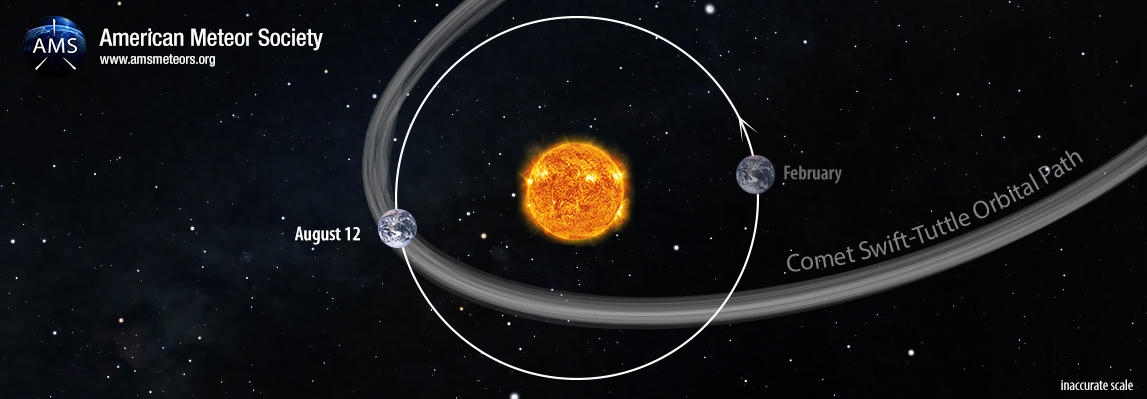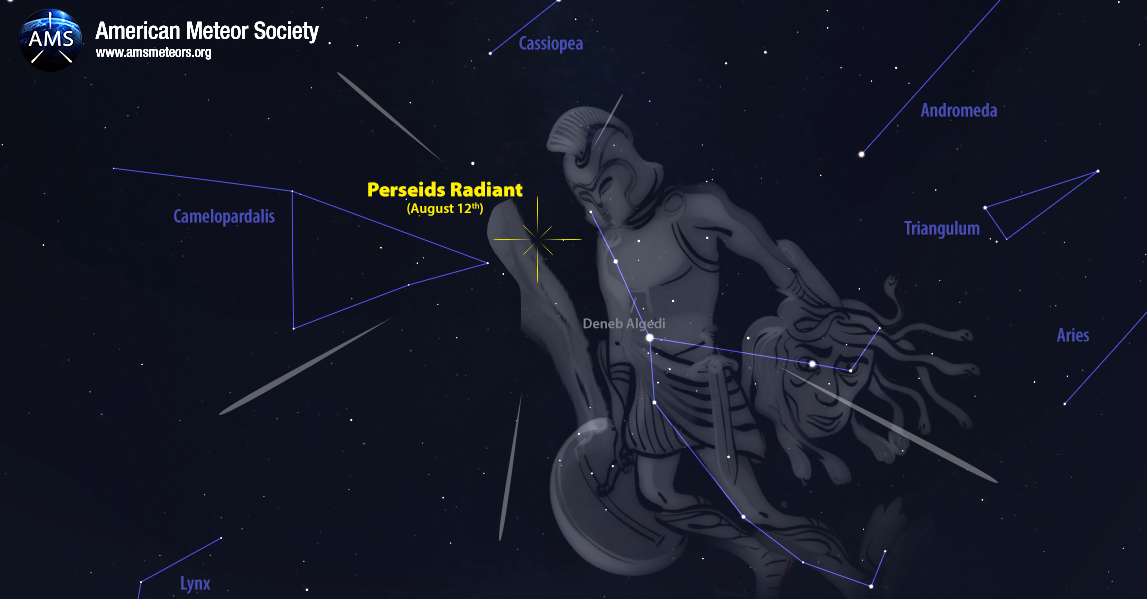
The Perseids are often the most impressive Meteor Shower of the year for the Northern Hemisphere. The Perseids offers a consistently high rate of meteors every year and it occurs in August when the temperatures are usually nice enough for a night under the stars!
Comet Dust
Most people have heard of the Perseid meteor showers, known for producing celestial fireworks every summer in the northern hemisphere. What they don’t often know is what causes this display and what causes it to produce varying levels of activity year to year. We see Perseid meteors when the Earth intersects the orbits of comet 109P/Swift-Tuttle. I mention “orbits” because the comet does not take exactly the same path each time it passes through the inner solar system. When the Earth happens to pass through the center of one of these paths we witness enhanced activity from the Perseids. Most of the time it passes between these paths. The meteors we seen in our skies are actually tiny particles of ice and dust that are released by the comet each time it passes near the sun. They strike the earth’s atmosphere at high velocity of 59 kilometeors per second. At that speed all Perseid meteors disintegrate while still high in the upper atmosphere. Larger Perseid particles produce fireball class meteors and persistent trains that remain in the sky a few seconds after the meteor has disappeared.
Peak: August 12th
The Earth begins to enter the outer edges of the paths of comet 109P/Swift-Tuttle around July 17 and leaves it around September 1st. We are closest to the core around August 12. This is when you will see the most activity. The number of particles in orbit are much greater than for most streams therefore we see more activity from this shower than most others. The closer you view to August 12, the more Perseid activity one will see. There is one other factor that comes into play year to year and that would be the moon. A great majority of the particles the Earth encounters are very tiny and produce meteors so faint that they are invisible to the naked eye. Of course there are Perseid meteors bright enough to be seen but most of these are also faint.

If you try and view the Perseids with a bright moon in the sky the moonlight will obscure these fainter meteors. Unfortunately this is the case this year with a full moon occurring on August 7th. By the time the 12th arrives the moon will have waned to approximately 80% illuminated. This is not much better than a full moon and will certainly pose a challenge in viewing the Perseids this year. To alleviate this problem one could try to view the display before the moon rises, which would be approximately 23:00 local summer time on the evening of the 11th. Unfortunately at that time the Perseid radiant, the area of the sky that Perseid meteors appear to shoot from, is located low in the northern sky and the number of meteors seen is the lowest. However, these meteors tend to be very long and long-lasting so it is definitely worth trying to see some of them. Once the moon has risen, it would be advisable to face away from it so that you save your night vision and face the darker portions of the sky where more activity can be seen. Perseid meteors can be seen in all parts of the sky. If you focus on one part of the sky then Perseid meteors will all have similar paths and velocities, only the brightness will be different. This gradually changes throughout the night, depending on the position of the radiant in Perseus.
Radiant
Meteor Showers are named for the constellation out of which they seem to come. Because all of the particles are moving in roughly the same direction, the meteors which strike our atmosphere all “point” back to the direction of the comet’s path. This point in the sky is called the Meteor Shower Radiant. The Perseids appear to come from a point next to the constellation of Perseus. Perseids can be seen anywhere in the sky, but the direction of motion, when traced back, will point to a point next to the Perseus constellation.

The best time to see Perseid activity is when the radiant lies highest above the horizon in a dark sky. For most potential observers this occurs near 4:00 local summer time. At this time you should be able to see 20-30 Perseids per hour, depending on the transparency of your sky. These rates are better than most of the major annual showers so it is definitely worth trying to view the display this year despite the moonlight. There will also be other meteors visible besides the Perseids. These meteors will be far less numerous and will possess varying velocities and paths through the sky. If you are clouded out on the evening of August 11 or the morning of the 12th, meteor activity will still be good the following night and for a few nights after. The good news for Perseid observers is that the 2018 display will occur near a new moon, when the moon is located near the sun and not visible at night.
We encourage observers to not only view this display but to make scientifically useful hourly counts of the meteors you see. Helpful hints on how to do this are available here. If you are experienced, don’t hesitate to .
Photograph meteors
The Perseids also offer a good opportunity to photograph meteors. To accomplish this you need a camera capable of taking exposures of at least 60 seconds. It also advantageous to have a wide field lens such as a 24mm or 28mm. These lenses are normally “slow” with a focal ratio of 3.5 or higher. These lenses are still capable of capturing meteors but the lower the focal ration the better as “faster” lenses are more capable of capturing these fast streaks of light. If you simply aim your camera at the sky your time exposure will show the stars trailing through the frame. Meteors will appear as straight streaks of light crossing these star trails. Advanced astrophotographers use motorized mounts for their cameras to follow the stars and to avoid star trails. Meteor streaks will appear as they do in the sky, as streaks of light against a starry background.
Clear Skies!




 You saw something bright and fast? Like a huge shooting star? Report it: it may be a fireball.
You saw something bright and fast? Like a huge shooting star? Report it: it may be a fireball.  You counted meteors last night? Share your results with us!
You counted meteors last night? Share your results with us!  You took a photo of a meteor or fireball? You have a screenshot of your cam? Share it with us!
You took a photo of a meteor or fireball? You have a screenshot of your cam? Share it with us!  You caught a meteor or fireball on video? Share your video with us!
You caught a meteor or fireball on video? Share your video with us!
One comment
Everything is very open with a really clear clarification of the issues.
It was really informative. Your site is very useful.
Many thanks for sharing!